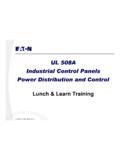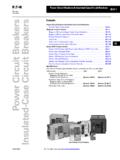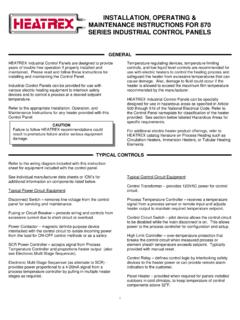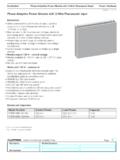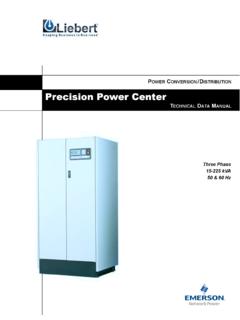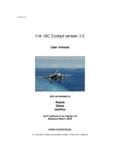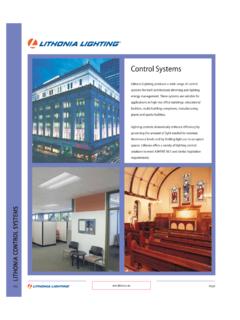Transcription of FPE Panels – Hazard or Hype? by Douglas Hansen
1 Federal Pacific Panels Page 1 of 7 FPE Panels Hazard or hype ? by Douglas Hansen This article focuses on the controversy over inspecting and reporting Federal Pacific Panels . It has been published in the maga-zine for the California Real Estate Inspec-tion Association and in other technical jour-nals. FPE Panels Hazard or hype ? Federal Electric later known as Federal Pacific Electric (FPE) was a popular manufacturer of Panels and breakers from the mid-1950 s until the early 1980 s. Based in New Jersey, their products were very popular throughout the counry, and some communities have FPE Panels in almost every home. For years, stories have circu-lated about the hazards and defects unique to this equipment, and the darker rumors include tales of product recalls, fraudulent manufacturing, and house fires resulting from failed breakers.
2 Inspectors and electri-cians share tales of breakers falling out of Panels when the deadfront is removed, or breakers failing to shut off when the handle is operated. Home inspectors need the facts so they can present their clients with accu-rate information on which to base a decision on accepting or replacing FPE Panels . Problems with FPE Panels can be broken down into 3 basic categories: First, there is the simple fact that the equipment is old, and manufactured to less stringent codes and standards than modern equipment. Electrical equipment is not something that improves with age or use. Second, there are problems unique to the design of the FPE Stablok breakers, problems that are not found in other equipment this age. Third, there are issues of manufacturing defects and circuit breaker failures. This last issue causes the greatest concern; what good is a circuit breaker that won t trip when overloaded or shorted?
3 What good is a breaker that doesn t de-energize the circuit when the handle is tripped? Older isn t Better Several of the problems found with FPE Panels are found in other brands of equip-ment of the same age. There is less gutter space in the panel than we find in modern equipment. The result is crowding of the wires in the Panels . It is sometimes impos-sible to see all of the terminals in an FPE panel. The space for bending wires is also less than required in modern Panels . The rules that proscribe minimum wire bending space are found in the National Electrical Code (NEC) in section in the 2002 edition. Over the years, the required mini-mum space has increased, with the most significant changes in the 1981 NEC, near the very end of the days when FPE Panels were made. FPE manufactured some pan-els with less clearance than the minimum code rules by installing the lugs at an angle, so the conductor was already parallel to the wall opposite the breaker terminal (figure 1).
4 However, the bends shown in figure 1 de-feat the purpose of the angled lugs, and the wire is bent too sharply. Figure 1 Insufficient wire bending space Federal Pacific Panels Page 2 of 7 The bus bars on several of the FPE models were set on springs, with a depth adjust-ment that enabled the position of the break-ers to be moved forward or backward. For a recessed panel, this feature allowed the breakers to be brought out flush to the deadfront cover even if the panel set too far back into the wall. The code today does not allow this, and states that bus bars must be rigidly mounted (section ). Rigid mounting prevents the entire bus from mov-ing when a single breaker handle is oper-ated. Another problem with spring-mounted bus bars is that the breakers sometimes push against the deadfront cover, creating a danger to the inspector when they remove and put back the deadfront cover.
5 Since the 1984 edition of the NEC, breakers that operate with their handles in a vertical position must be on when in the up position, and off in the down position. Prior to that time, several manufacturers made equip-ment such as that seen in figure 2, with a row of breakers that was on when down and off when up. The word on when upside down is no. Inspectors encountering such equipment might want to warn their clients that these FPE breakers are on when facing the outer edge of the panel, and off when facing the center of the panel. It can be very difficult to remove these covers without ac-cidentally tripping a breaker. Figure 2 Breakers that are on when down Prior to 1984, many manufacturers offered split bus Panels for residential use, such as the panel in figure 3. These Panels have no main breaker. They do meet the rule re-quiring no more than 6 disconnects, and one of these disconnects feeds a separate bus that typically contains the 15 and 20 amp 120 volt circuits.
6 The advantages of a split bus panel were purely economic. If the largest breaker was the one feeding the secondary bus, and it was rated at 50 amps, it cost less than a single main 100 amp breaker. In addition to the six disconnects rule for service equipment, another rule also applies to Panels that are categorized as lighting and appliance Panels . These are Panels where more than 10% of the break-ers are rated 30 amps or less and serve cir-cuits with neutrals. These lighting and appli-ance Panels must be capable of having their power disconnected by not more than 2 hand movements. Until 1984, the code ex-empted these Panels from the two-disconnects rule when they served as resi-dential service equipment. Today, the code allows them to remain when they are exist-ing service equipment, though it would not allow a new installation of such a panel. Figure 3 Split Bus Panel Federal Pacific Panels Page 3 of 7 The panel in Figure 3 has 5 breakers at the top.
7 The 3 on the left control a water heater, clothes dryer, and electric space heater. The top right breaker controls the range/oven circuit, and the one just below it controls the lower bus section, with all the lighting and appliance circuits. The wires from this breaker to the lower bus section are the sign that this is a split bus panel. There are at least 5 design issues that are no longer allowed by code; the gutter space, the wire bending space, spring-mounted bus, breakers that are on when down, and the split bus service equipment. These is-sues mean that a panel that has been sitting on the hardware store shelf for 20 years would not meet today s code, despite the UL listing of the panel at the time it was manufactured. Another even greater con-cern is that older breakers of any brand do not become more reliable with age. The internal mechanical components can be-come corroded or distorted, and the springs, hinges, and levers inside the breaker might not operate as designed after sufficient pas-sage of time.
8 Most breaker manufacturers guarantee their products for only a year, and for valuation purposes breakers are considered fully depreciated after 15 years. Figure 4 Overcrowded FPE panel with wires obscuring terminals, neutral bar, and bonding jumper. If the wires press against the deadfront, it may pop out and trip the breaker handles as soon as the panel screws are removed. The Unique FPE Design Inspectors might find that their first problem with FPE is the difficulty in removing the deadfront cover without tripping the break-ers. Several models of FPE Panels have breakers that are on when the handle is po-sitioned toward the outside of the Panels . The handles stick out slightly over the dead-front, past the twist-out opening for the breaker. To remove the cover, it is neces-sary to first lift it slightly away from the panel, then slide it under the handles of one row while lifting the cover off the other row.
9 If an inspector pulls the cover straight off, it is likely that some of the breakers will acci-dentally trip. The Panels in figures 2, 3, and 4 have this problem. Figure 5 Scorched Bus Bar Most plug-in circuit breakers have a set of jaws that fit over a bus bar, bringing the metal of the jaw into a parallel position to the bus bar. The FPE Stablok design is the opposite; the breakers have a set of prongs that are inserted into a slot in the bus bars (figures 5 8). The result is a connection between two pieces of metal that are at right angles to each other, only touching at their edges. One of the common FPE problems is to find the breakers loose in the bus bars. Good electrical connections require contact pressure. If the FPE stab only touches one edge of the opening in the bus, the lack of contact pressure and the small contact area will combine to produce arcing and over-heating. If you remove the breakers from the panel, it is not uncommon to find scorch marks on FPE bus bars, as in figure 5.
10 Federal Pacific Panels Page 4 of 7 E-type Wafer Breaker E-type Wafer Breaker F-type Full Size Breaker F-type Full Size Breaker Double E-type Breaker Double E-type Breaker Figure 6 E and F Breakers Most Panels accept two different sizes of breakers full size and half size, or wafer breakers. By using the half-size breakers, the number of circuits in the panel can be doubled. Because more circuit breakers and more connected load will increase the heat on the bus bars, manufacturers must install some physical means of limiting the number of breakers that can be installed in the panel. Panels with an inherent limitation on the number of breakers are referred to by UL as Class CTL Panels , and the breakers that go into them will also be categorized as Class CTL. Most Panels can be completely filled with wafer breakers without exceeding the limits set by the UL standard, which as-sumes 10 amps of load per breaker pole per leg.
